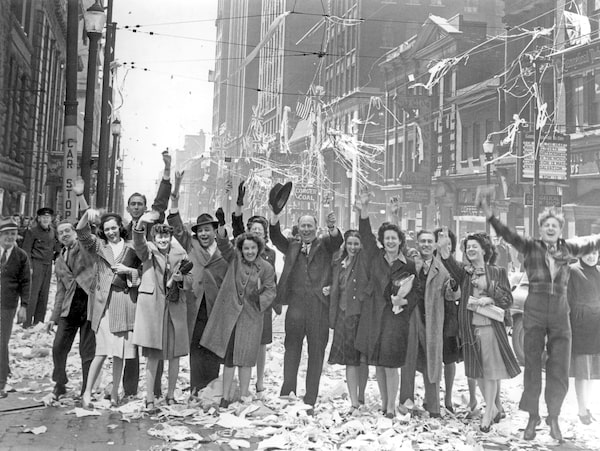
Celebrations erupt in Toronto's downtown at the announcement of VE Day on May 7, 1945.The Globe and Mail
Tim Cook is acting director of research at the Canadian War Museum and author of the forthcoming book The Fight for History: 75 Years of Forgetting, Remembering, and Remaking Canada’s Second World War.
How will it end?
We are all asking ourselves this amid the worldwide pandemic. We do not know when the coronavirus will subside, and that terrifies us.
We know more lives will be lost, our economy further disrupted and our society changed. But like the famines, plagues and wars of the past, it too will end.
And yet the uncertainty is unsettling. If we only knew where we were in the fight against the pandemic, we could more readily steady ourselves for the long battle that is in front of us.
But we don’t, just as people in the past facing worldwide crises did not know.
For some guidance, or at least a reference point, many are turning to history to clarify the present, and perhaps as a way to arm themselves for the extended forced march into the future.
There are analogies to the massive, society-wide mobilization for the Second World War, during which Canada, a country of about 11.5 million people, stood by its allies France and Britain and declared war on Germany in September, 1939. Those Canadians also did not know how that war would end. In fact, in 1940 and 1941, it looked fairly certain that Nazi Germany would conquer Europe and possibly Britain, or at least force a brutal negotiated peace on the island kingdom as it ruled over Western Europe.
The greatest shock in the early part of the war to Canadians – and the Western world – was the fall of France. After the German annihilation of Polish forces in September, 1939, followed by the cruel occupation, there was a period of relative inactivity along the western battle front. The Germans took months to marshal their forces against the dug-in French armies on their defensive Maginot Line, with the British army on the northern flank. And then the two sides waited.
Canada was far from the crisis and its armed forces initially weak. Its best defence remained its geography. And yet all Canadians waited for the storm to come from the most powerful military in the world.
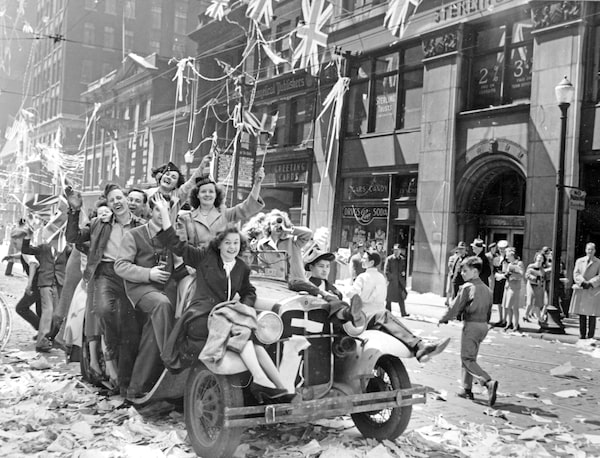
Toronto's Bay Street filled with people parading joyfully, waving flags and driving in decorated cars to celebrate the end of Second World War.The Globe and Mail
When the Germans unleashed their blitzkrieg on May 10, 1940, rapid-moving tanks and mechanized infantry, supported by diving bombers, devastated the French static defences. The immobile French soldiers were hammered in battle and then left behind as the German armoured forces plunged ahead. Chaos reigned.
France fell in six weeks, a crushing defeat for a country that had survived four long years of the Great War and paid a terrible price. Meanwhile, the British were saved by the miracle at Dunkirk, which allowed them to fight another day. And fight they would, with Canadians at their side. The United States would join later, in December, 1941, after it was attacked by Japan at Pearl Harbor. The Americans had hoped that the war infecting Europe and the Pacific would not come to their shores. It did.
France’s defeat shattered Canadian complacency and the country lurched to action. Tens of thousands enlisted in newly raised military units and the National Resources Mobilization Act was rushed through the House of Commons in June, 1940. It put Canada on a stronger war footing and, among other things, brought in conscription for home defence. These were hugely disruptive changes, but Canadians accepted them even as fear and doubt gnawed away.
From that point onward, war industry shifted rapidly from civilian goods to producing staggering amounts of guns, trucks, bombers, warships and other munitions. Hundreds of thousands of additional women entered the work force as more than a million men, and some 50,000 women, served in uniform. Societal norms were shifted and then shattered. Culture was weaponized to support the war and every form of available media – print, radio, public lectures and film – urged Canadians to fight or serve the war machine.
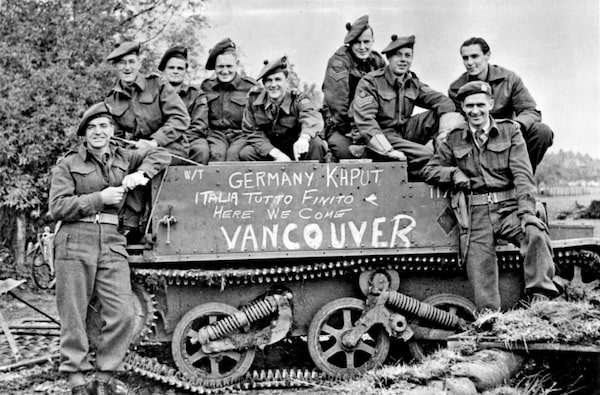
These Vancouver soldiers, members of the Seaforth Highlanders of Canada, painted 'Germany Kaput ... Here we come Vancouver' on hearing of the war's end. Photograph believed to be taken in the Netherlands in May, 1945.Canada Department of National Defence/Library and Archives Canada / CP
Few remained unaffected by the war. And most understood that the growing crisis could only be resolved by enlisting much of the population in the war effort. Even so, Canada, Britain and the other members of the Allied coalition would face a string of defeats in a dizzying and depressing onslaught.
In the global war, there would be untold trauma to those in uniform and civilians targeted by armies or air forces. In total war, all were potential combatants or victims. Eventually, some 60 million people would be killed through war, starvation and genocide.
In this savage fight against fascism, the defeats piled up for the West and no one knew how the war would end. But it was utterly necessary that the Allies won – no negotiated settlement with the Nazi dictator Hitler was acceptable. The Canadians, British, Americans and all the others banded together like never before.
The defeats galvanized public opinion in most parts of the country and Canadians accepted the extraordinary intrusion of the state into their lives in the name of victory – and in ways that were not acceptable during peacetime. Across the country, in rural areas and cities, there was a willingness to endure hardship.
The Canadians who lived through the Second World War, battling on the field or on the home front, engaged in heroic acts, but they did not always do what was right. There was a thriving black market late in the war, some people hoarded goods and sometimes Canadians acted out of fear. In the most egregious case, some 23,000 Japanese Canadians were forcibly relocated from the coast of British Columbia, as anxiety over imagined subversive actions mixed with latent racist feelings. Those actions left a lasting and deep hurt in that community.
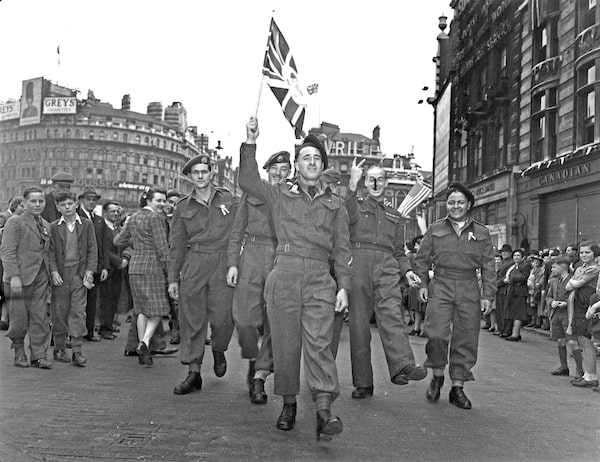
Canadian soldiers celebrate VE Day at Piccadilly Circus in London on May 8, 1945.Lieut. Arthur L. Cole/Canada Department of National Defence/Library and Archives Canada via Reuters
During the existential threat of the war from 1940, through immense service and deep sacrifice, Canadians in uniform, supported by those at home, made the tough yards against the enemy on battlefields around the world, at sea, in the air and on land.
The war ground on, but eventually victory appeared in the distance. It was probably sometime in the late summer of 1944, after D-Day and the gut-churning battles in Normandy, with the bombers pummelling German cities, and with the Soviet Red Army rolling toward Germany from the East.
And yet still there were many battles to be fought to the bitter end, with millions of lives lost. Finally, Allied victory was declared on May 8, 1945, in Europe, and on Aug. 15, 1945, against Japan.
The cost of victory was fearfully high. In Canada, close to 45,000 men and women in uniform were killed. They lie in cemeteries around the world and often their names appear on memorials in their home towns across this country.
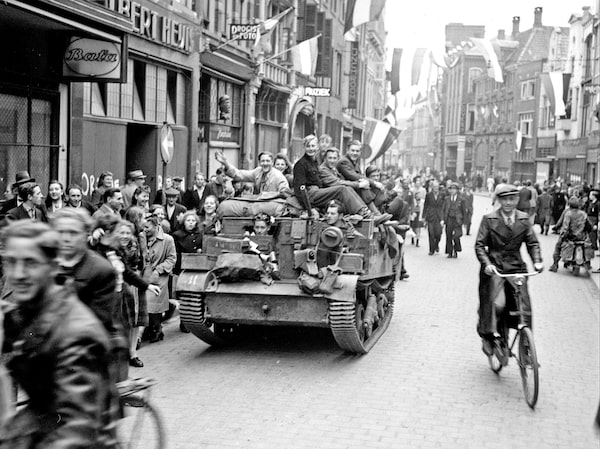
Dutch civilians on a Bren-gun carrier of the Chaudiere Regiment celebrate the liberation of the city in Zwolle, Netherlands on April 13, 1945.DONALD I. GRANT/Library and Archives Canada / CP
Today, in the midst of this pandemic and the 75th anniversary of the end of the war, we continue to wonder where we are in the long fight. We have come through our equivalent of the fall of France in 1940. We are mobilizing with grim determination. And yet our D-Day is still some time ahead in an unknowable future.
We are facing a different war, where tens of thousands of lives are at risk, but we have rallied and come together against this new enemy. We – two metres apart – are standing together, as a country.
We have again turned to the state for solutions: We are gearing up a new “wartime” economy, doctors and nurses fight on the front lines, and the rest of us are trying to “back the attack,” to use the Second World War phrase. There are individual and collective battles, and both must be won for final victory.
Like the Second World War, there is no escaping this all-encompassing fight against an invisible enemy. Like Canadians of that wartime generation 75 years ago, we do not know when this war will end.
We understand that it will cost dearly, perhaps more than we can possibly imagine, even as we scan the papers or social-media feeds for the growing casualty lists – just like Canadians who waited and worried in the war against fascism.
And yet we must also know that, like Canadians of 75 years ago, we will prevail.
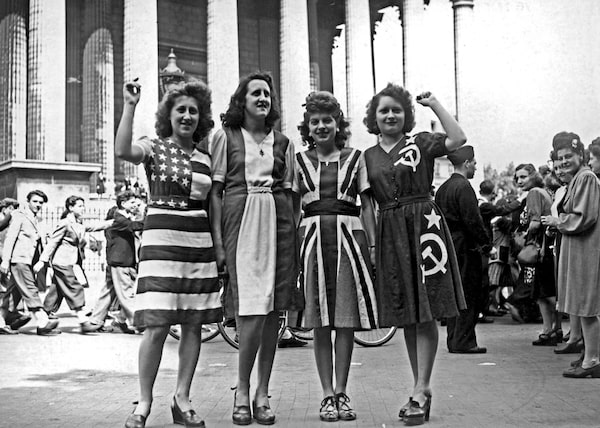
A group of women wearing dresses representing flags of the Allied powers outside the Eglise de la Madeleine on VE Day in Paris, on May 8, 1945.Hulton ArchiveKeystone/Hulton Archive/Getty Images
Sign up for the Coronavirus Update newsletter to read the day’s essential coronavirus news, features and explainers written by Globe reporters and editors.